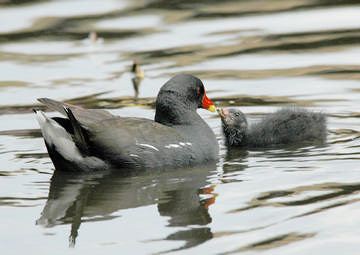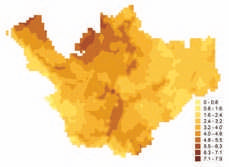
Moorhen © Mike Atkinson
Moorhens are present in the breeding season almost everywhere in Cheshire and Wirral up to an altitude of about 250 m in the eastern hills. This is our second most widespread breeding waterbird, headed only by Mallard. There has been a small net loss of 17 tetrads relative to our First Atlas, possibly from an element of under-recording, but perhaps birds have been displaced from some areas by the move of many Coots to smaller waters. Richard Elphick and Mike Scott, however, recorded Moorhens ‘nesting amicably in a small pool with nesting Coots’ near Alderley Edge (SJ87T). This species needs waters with some fringing vegetation, and readily suffers from unsympathetic riparian management.
They build their nest from the broad leaves of aquatic plants, the female laying an average of six eggs and sharing the three weeks of incubation with the male. They sometimes surprise observers by nesting in trees, using an old nest of a corvid or other species. Proof of breeding was obtained in 83% of the tetrads in which they were recorded, mostly (426 out of 488) from observers seeing chicks during an extended season lasting from mid-April on, often into September. The adults often build one or more ‘brood platforms’, rudimentary nest-like structures on which the chicks can rest, wait for food to be brought to them, roost overnight and perhaps escape predation from pike. Mink are a big problem for them, however, as can be cats when they spread out onto waterside meadows and lawns. Moorhens usually raise two broods of chicks, sometimes even three, and adopt an unusual breeding strategy in which the first-brood chicks help to feed their younger siblings from the second nest, thus helping to relieve the burden on their parents and giving themselves some practice for their own breeding attempts in the next year. Some nests hold more than the normal size of clutch, either from egg-dumping by neighbouring females, or because of cooperative nesting when two, three or four females were paired to the same male (BTO Second Atlas). In cooperative nesting, the females share the parental duties along with the male; where studied in detail, the females have been shown to be mother and daughter.

Moorhen abundance.
Moorhens were frequently noted nesting on ponds in gardens, farms and on golf courses. The recorded habitats show 35% on ponds and 33% on small waterbodies, with only 15% using the larger meres, lakes and reservoirs; 17% of breeding Moorhens were on linear watercourses, mostly canals, where they seem content to co-exist with traffic from holidaying narrowboats. A count in 1996 found seven nests along a 6 km stretch of the Bridgewater Canal near Warrington and in 1998 ten pairs were reported in 4.3 km of the Shropshire Union in south Cheshire (CWBR).
The BTO analysis of the Cheshire and Wirral BBS data shows that the breeding population in 2004-05 was 7,940 birds (5,420-10,460), corresponding to an average of about 7 pairs per tetrad with confirmed or probable breeding. This is one of the few species where this survey gives a population figure significantly lower than the estimate from our First Atlas, which was 6,000 pairs. It is not known if this represents a real drop or an over-estimate of the 1984 total. Nationally, the breeding population of Moorhen has been fairly stable, dropping in years following extra mortality in hard winters. Reductions in the number and quality of farmland ponds, and the spread of mink along watercourses, have been suggested as possible causes of decline.
Nevertheless, 7,940 birds is more than 2.2% of the British population, showing that the county is disproportionately important for the species.
Sponsored by Patrick King

